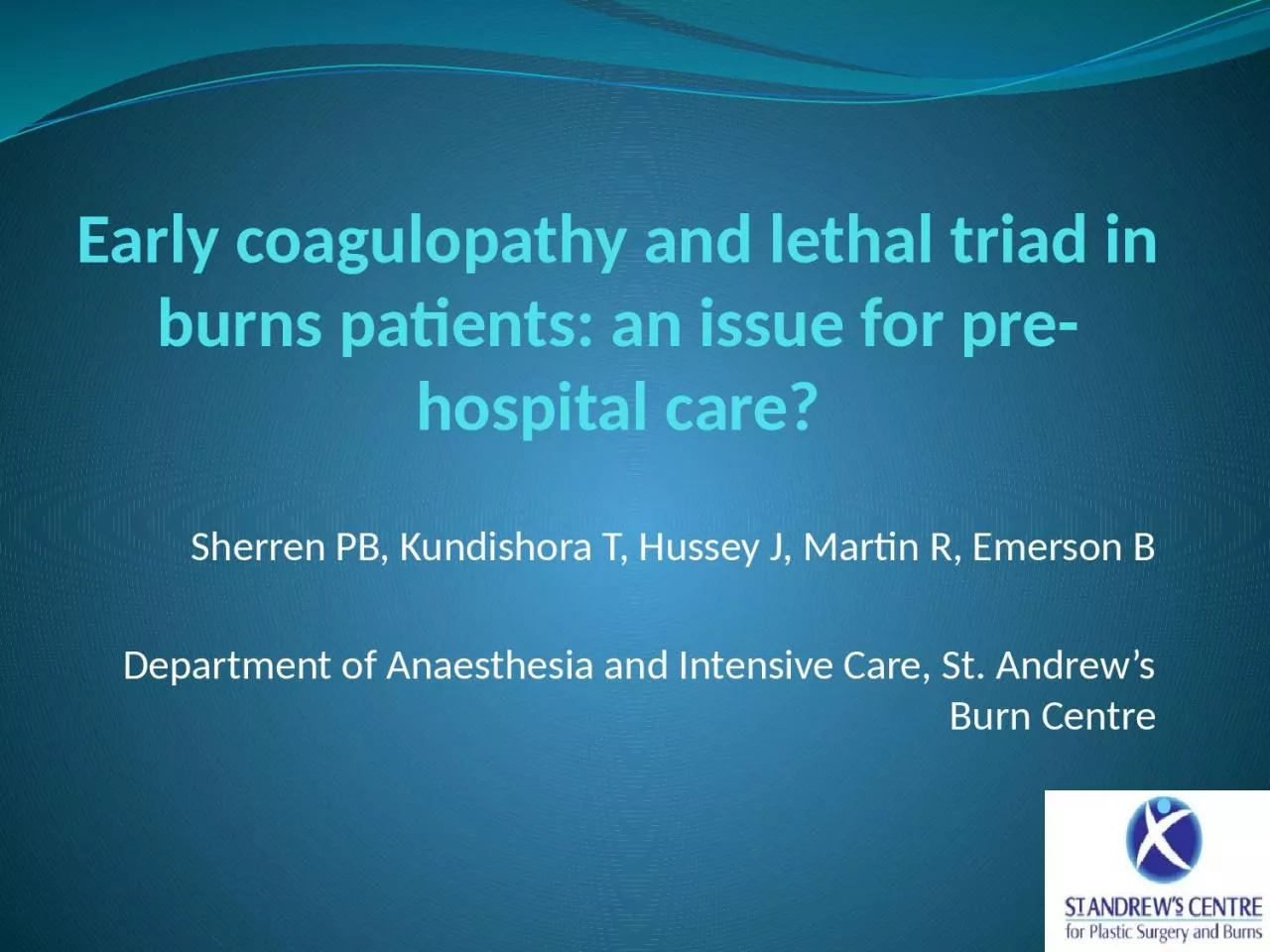

triad in burns patients an issue for prehospital care Sherren PB Kundishora T Hussey J Martin R Emerson B Department of Anaesthesia and Intensive Care St Andrews Burn Centre ID: 929649
Download Presentation The PPT/PDF document "E arly coagulopathy and lethal" is the property of its rightful owner. Permission is granted to download and print the materials on this web site for personal, non-commercial use only, and to display it on your personal computer provided you do not modify the materials and that you retain all copyright notices contained in the materials. By downloading content from our website, you accept the terms of this agreement.
Slide1
Early coagulopathy and lethal triad in burns patients: an issue for pre-hospital care?
Sherren PB, Kundishora T, Hussey J, Martin R, Emerson BDepartment of Anaesthesia and Intensive Care, St. Andrew’s Burn Centre
Slide2The lethal triad
The ‘lethal triad’ is a well described entity in the trauma population and is associated with significant mortality. Moore EE. Am J Surg 1996;172:405-410
Major burn patients are exposed to similar physiological
insults
Little is known about the incidence and effect of an early coagulopathy and lethal triad in burns patientsA lethal triad could impact on early surgical procedures, CVS stability and septic complications
Slide3Slide4Coagulopathy
Acute traumatic coagulopathy (ATC) is a well described phenomenon in the trauma population associated with significant mortality Brohi K et al. J Trauma. 2003;54:1127-1130ATC is an impairment of haemostasis involving a complex dynamic interaction between endogenous anticoagulants and
fibrinolysis
ATC
is driven by an endothelial injury and hypoperfusion, which results in in increased thrombomodulin expression and APCAn early burn induced coagulopathy has yet to be demonstrated
Slide5Hypothermia
Significant problem!Factors involvedLarge volume fluid resuscitationThermal tissue injury impairs skin’s insulating abilityAnaesthesia impacts thermoregulationImpaired endogenous heat production as a result of anaerobic metabolism
Reluctance to warm burn patients by medical professionals?
Slide6Acidaemia
Major burns are characterised byDirect endothelial injurySystemic hypoperfusion
H
ypovolaemia
/ haemoconcentration Impaired myocardial contractility and cellular hypoperfusion.This decreased oxygen delivery results in a shift to anaerobic metabolism, lactate production and metabolic acidaemiaThe initial lactate is a strong predictor of mortality in burns patients. Latenser
BA.
Crit
Care Med
. 2009 Oct;37(10):
2819-26
Slide7Slide8Aim
The primary aim of this study was to identify a clinically significant early burn induced coaguloapthy and lethal triad in thermal injuriesWe also sought any association with the validated abbreviated burn severity index (ABSI), fluid administration and mortality
Slide9Abbreviated Burn Severity Index
Slide10Methods
Patients with TBSA burns ≥30% from October 2008 to December 2011 were identified from the metavision databaseA structured and anonymous metavision review was conducted The database was scrutinised for a predetermined list of demographics, interventions, admission observations and
investigations
Exclusion
criteria were: associated major trauma, arrival at the burn centre>12 hours after burn, significant CO/Cyanide poisoning, pre-existing coagulopathy, any PRBC/FFP/PCC administration and non-thermal injuries
Slide11Definitions
Coagulopathy - PT≥14.7/APTT≥45 seconds (Local lab. reference & Davenport et al. Crit Care Med
2011;39(12):
2652-2658)Hypothermia - Temperature≤35.5°C Acidaemia - pH≤7.25
Slide12Lethal Triad
Slide13Demographics
Lethal
Triad
P
-value
Present
(n=15)
Absent
(n=102)
Age in years, mean (SD)
46 (20.9)
33.0 (21.9)
0.033*
Sex (M/F)
10/5
65/37
1
TBSA burn, mean (SD)
59.2 (18.7)
47.9 (18.1)
0.027*
Inhalational injury present
13 (86.7%)
31 (30.4%)
<0.0001*
Abbreviated burn severity index, median (IQR)
12 (9-13)
8.5 (6-10)
0.0011*
Time from burn to arrival Burn Centre in minutes, mean (SD)
352 (107.5)
361.5 (160.8)
0.83
Fluid received prior to arrival at Burns centre. ml, mean (SD)
4783.3 (2140.1)
4167.1 (2910.6)
0.43
Fluid deficit according to Parkland formula on arrival in Burns centre. ml, mean (SD)
1903.2 (2095.6)
301.7 (2287.5)
0.012*
Mortality rate at 28 days (%)
10/15 (66.7)
12/102 (11.8)
<0.0001*
Slide14Coagulopathy
39.3% of the 117 patients were coagulopathic on admission There was no significant correlation between the PT and volume of fluid administered (p - 0.095, r - 0.155)The 28 day mortality rate for patients with a coagulopathy of 39.1% was significantly higher than the 8.5% of those with normal coagulation (
p
-0.0001
)The predictive value of an early coagulopathy in regards to 28 day mortality was sought using logistic regression analysis. All components of the ABSI were adjusted forAn earlier coagulopathy was an independent predictor of 28 day mortality, OR 3.42 (1.11-10.56)
Slide15Incidence of coagulopathy with ABSI
Pearson product moment correlation coefficient r - 0.292 and p - 0.0013
Slide16PT vs
serum lactate Pearson product moment correlation coefficient, r - 0.292 and p - 0.001
Slide17Summary
In patients with major thermal injuries there is a clinically significant early burn induced coagulopathyThis coagulopathy correlates to serum lactate and ABSI but is unrelated to fluid administrationAn earlier coagulopathy was an independent predictor of 28 day
mortality
A subgroup of major burns patients exhibit the lethal triad
which is associated with an increased mortality
Slide18Conclusion
In the pre-hospital management of major burns it is vital to accurately assess the burn area and resuscitate appropriately to limit tissue hypoperfusionAn acute burn induced coagulopathy has significant bleeding implications for any surgical proceduresEnsure temperature conservationHighest possible ambient temperature
Use of Clingfilm
, space
blankets and layering techniques Use of active warming methods such as heat pads and the En-Flow fluid warmer
Slide19Questions?